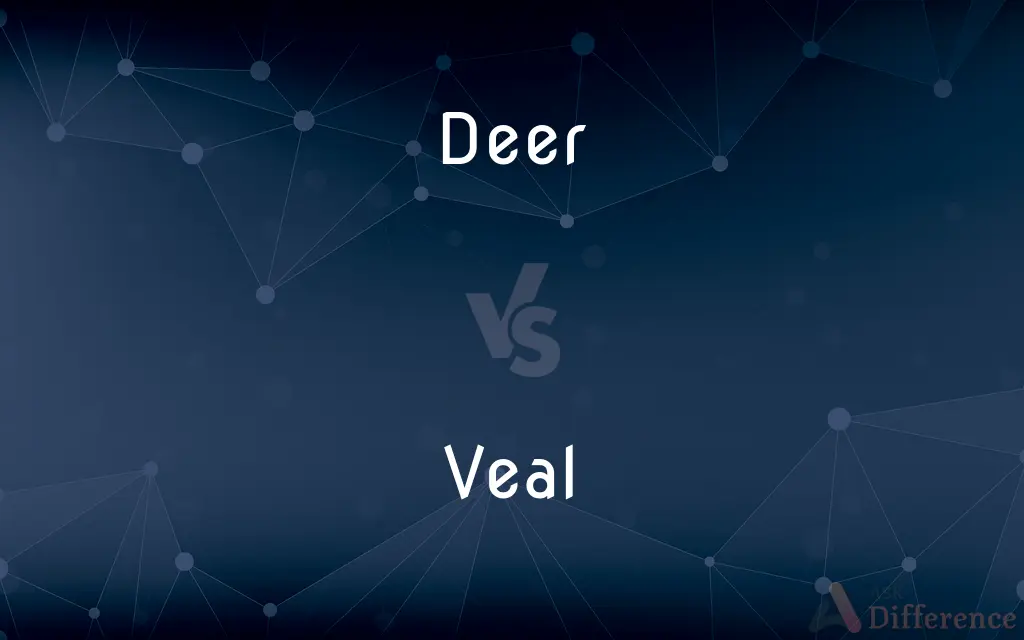Deer vs. Veal — What's the Difference?
By Fiza Rafique & Urooj Arif — Updated on April 27, 2024
Deer refers to a family of wild or semi-domesticated animals, while veal is the meat from young cattle, specifically calves.

Difference Between Deer and Veal
Table of Contents
ADVERTISEMENT
Key Differences
Deer encompass a wide range of hoofed mammals found in various environments around the world, known for their antlers typically seen on males. They are significant in both ecological and cultural contexts. On the other hand, veal refers to the meat of calves that are typically slaughtered between six to seven months old, prized for its tender texture and mild flavor.
While deer can be farmed or hunted for meat, which is also called venison, their existence extends beyond being a food source. They play crucial roles in biodiversity and are often featured in mythology and symbolism. Conversely, veal is specifically produced for culinary purposes, with specific breeding and rearing practices focused on creating high-quality meat.
The consumption of venison, or deer meat, is associated with game and traditional cuisine, offering a leaner alternative to beef and is celebrated for its rich, distinctive flavor. Veal, being from young cattle, has a more delicate texture and is often seen in fine dining contexts, frequently featured in European cuisines.
Ethical considerations also play a significant role in the consumption of both. The hunting of deer is subject to regulations aiming to balance ecological impact, whereas veal production has been scrutinized for animal welfare concerns, prompting changes in calf-rearing methods to improve standards.In terms of availability.
Deer meat varies widely based on local wildlife populations and hunting seasons. In contrast, veal is more consistently available due to being farmed, though its consumption can be subject to cultural preferences and ethical viewpoints.
ADVERTISEMENT
Comparison Chart
Definition
A family of wild or semi-domesticated mammals, often hunted.
The meat from young cattle, specifically calves.
Use
Hunting, ecological, cultural significance.
Culinary, specifically for tender meat.
Flavor and Texture
Rich, gamey, lean.
Mild, delicate, tender.
Ethical Concerns
Hunting regulations, ecological impact.
Animal welfare, rearing practices.
Cultural Role
Featured in mythology, symbolism, traditional diets.
Common in fine dining, European cuisine.
Compare with Definitions
Deer
Hoofed mammals with distinct antlers, often hunted.
Deer roam freely in the national park.
Veal
Considered a delicacy in many European cuisines.
Veal Parmesan is popular in fine dining restaurants.
Deer
Found in diverse habitats from forests to grasslands.
White-tailed deer are commonly seen in North American forests.
Veal
Meat from young cattle, known for its softness.
Veal scallopini is a classic Italian dish.
Deer
Subject to hunting laws for population control.
The deer hunting season is regulated to prevent overpopulation.
Veal
Typically slaughtered at six to seven months old.
Veal calves are raised primarily for high-quality meat production.
Deer
Deer or true deer are hoofed ruminant mammals forming the family Cervidae. The two main groups of deer are the Cervinae, including the muntjac, the elk (wapiti), the red deer, the fallow deer, and the chital; and the Capreolinae, including the reindeer (caribou), the roe deer, the mule deer, and the moose.
Veal
Associated with specific rearing practices for tenderness.
Veal is often produced from calves kept in controlled environments.
Deer
Any of various hoofed ruminant mammals of the family Cervidae, characteristically having deciduous antlers borne chiefly by the males. The deer family includes the white-tailed deer, elk, moose, and caribou.
Veal
Ethical concerns have led to improved rearing standards.
Free-range veal is becoming more common as consumers demand better animal welfare.
Deer
A ruminant mammal with antlers and hooves of the family Cervidae, or one of several similar animals from related families of the order Artiodactyla.
Veal
Veal is the meat of calves, in contrast to the beef from older cattle. Veal can be produced from a calf of either sex and any breed; however, most veal comes from young males of dairy breeds which are not used for breeding.
Deer
(in particular) One of the smaller animals of this family, distinguished from a moose or elk
I wrecked my car after a deer ran across the road.
Veal
The meat of a calf.
Deer
The meat of such an animal; venison.
Oh, I've never had deer before.
Veal
Also veal·er (vēlər) A calf raised to be slaughtered for food.
Deer
Any animal, especially a quadrupedal mammal as opposed to a bird, fish, etc.
Veal
The flesh of a calf (i.e. a young bovine) used for food.
Deer
Any animal; especially, a wild animal.
Mice and rats, and such small deer.
The camel, that great deer.
Veal
The female genitalia. en
Deer
A ruminant of the genus Cervus, of many species, and of related genera of the family Cervidæ. The males, and in some species the females, have solid antlers, often much branched, which are shed annually. Their flesh, for which they are hunted, is called venison.
Veal
To raise a calf for meat production.
Deer
Distinguished from Bovidae by the male's having solid deciduous antlers
Veal
The flesh of a calf when killed and used for food.
Deer
Venison refers to the meat from deer, known for its lean texture.
Venison is a popular choice in game cuisine.
Veal
Meat from a calf
Deer
Symbolic in many cultures, representing various attributes.
In Native American culture, a deer symbolizes gentleness.
Common Curiosities
What is deer?
Deer refers to members of a family of hoofed mammals, often characterized by the males' antlers.
Are there ethical concerns associated with consuming deer or veal?
Yes, deer hunting is regulated for ecological balance, while veal production has faced scrutiny over calf-rearing conditions.
How is the texture of deer meat compared to veal?
Deer meat is leaner and has a stronger, gamey flavor compared to the soft, mild flavor of veal.
What is veal?
Veal is the meat obtained from young cattle, specifically calves, noted for its tender texture.
How do deer and veal differ in culinary use?
Deer meat, or venison, is prized for its rich flavor and is often used in game dishes, while veal is valued in fine dining for its delicacy and mild flavor.
What are common dishes that use deer or veal?
Common venison dishes include stews and roasts, while veal is often used in dishes like veal Marsala and veal chops.
Why is deer symbolic in many cultures?
Deer symbolize various qualities such as agility, grace, and gentleness across different cultures and mythologies.
How is veal produced?
Veal is produced from calves raised specifically for meat, often under controlled conditions to ensure tenderness.
What are the main differences in how deer and veal are sourced?
Deer can be wild and hunted or farmed, whereas veal is specifically farmed under controlled conditions.
Is venison more nutritious than veal?
Venison is generally leaner and has fewer calories, making it a healthier red meat option compared to veal.
Share Your Discovery

Previous Comparison
Watertight vs. Waterproof
Next Comparison
Build vs. CreateAuthor Spotlight
Written by
Fiza RafiqueFiza Rafique is a skilled content writer at AskDifference.com, where she meticulously refines and enhances written pieces. Drawing from her vast editorial expertise, Fiza ensures clarity, accuracy, and precision in every article. Passionate about language, she continually seeks to elevate the quality of content for readers worldwide.
Co-written by
Urooj ArifUrooj is a skilled content writer at Ask Difference, known for her exceptional ability to simplify complex topics into engaging and informative content. With a passion for research and a flair for clear, concise writing, she consistently delivers articles that resonate with our diverse audience.














































